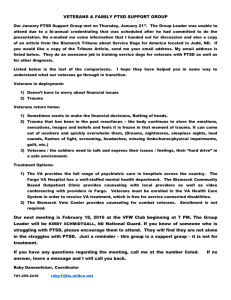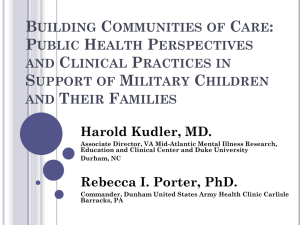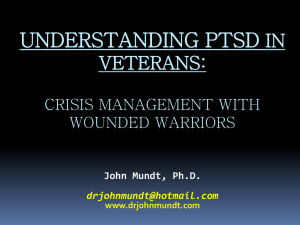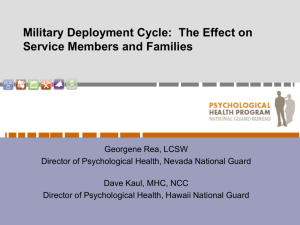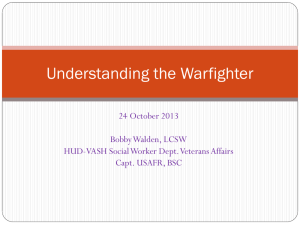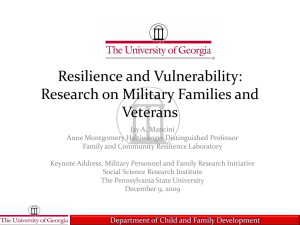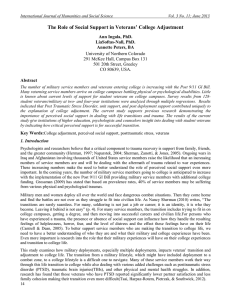families - Community Service Council of Greater Tulsa
advertisement
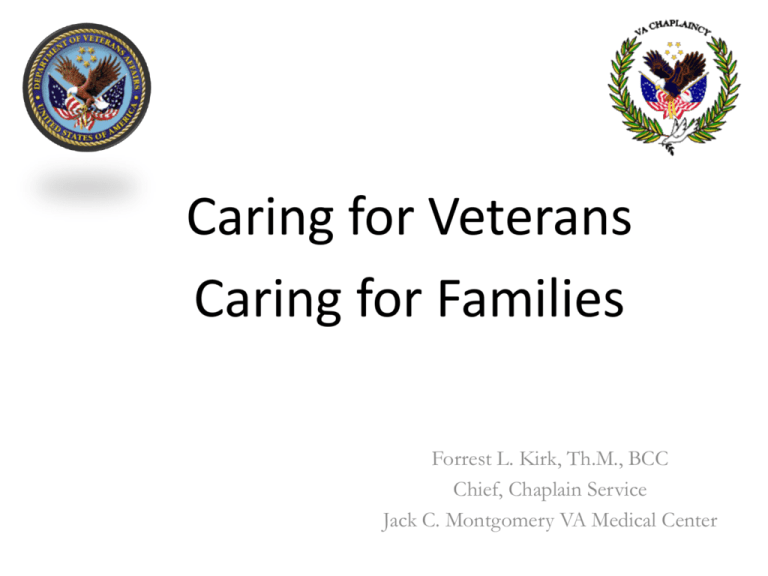
Caring for Veterans Caring for Families Forrest L. Kirk, Th.M., BCC Chief, Chaplain Service Jack C. Montgomery VA Medical Center 2 2 Objectives • Discuss Challenges During and After Deployment for Service Members and Families. • Explore VA Chaplain Opportunities and Approaches in caring for Veterans 3 Four Causes of Stress Injury INTENSE OR PROLONGED STRESS Life threat Events that provoke terror, horror, or helplessness Wear & tear Accumulation of stress from all sources over time Inner conflict Loss Death or injury of others who are loved and with whom one identifies Events that contradict deeply held moral values and beliefs 4 During Deployment Families • Feel Concern, worry or panic, loneliness, sadness • Have added family duties & responsibilities • Learn new skills, make new friends • Fear for their service member's safety • Feel overwhelmed • Experience financial difficulties • Deal with problems on their own • Do not always understand what their loved ones have been through • Are concerned about being needed and loved 5 Home is Different for Veterans Homecoming is disorienting and can represent a significant change for a family. They have learned to live without their military member. Neither the returning service member nor their family and friends are the same as they were before deployment to war. Families and friends must re-adjust and “re-set” upon re-integration. 6 Family Challenges • Military has high expectations of families both Active duty and Reserve components. • Family members are left with all responsibilities while loved ones are deployed. • Family members, are our neighbors, friends, co-workers and patients. • All families are changed as a result of a deployment. For a some family systems, these changes can be debilitating and life-altering. • LONG Term Effects (Alberta Martin, 2004). 7 War Comes Home . . . . . “The war was still in him, and it would be in him for a long time to come, for soldiers who have been bloodied are soldiers forever. They never fit in…That they cannot forget, that they do not forget, that they will never allow themselves to heal completely is their way of expressing their love for friends who have perished. And they will not change because they have become what they have become to keep the fallen alive.” Mark Halerpin, A Soldier of the Great War 8 Family Stress and Suicide Army: Health Promotion, Risk Reduction, Suicide Prevention Report 2010, (24) 9 Family Stressors Financial Physical Negative Coping Spiritual and Emotional Stressors Relationships Secondary Trauma Loss Moral 10 Secondary Trauma • Trauma also affects those who experience it indirectly. • Secondary, or vicarious trauma, refers to those people who care for, or are involved with, those who have been directly traumatized. • Symptomatology very similar to that of PTSD. 11 Family Re-setting Family Re-setting includes: – – – – – Re-establishing relationships (all types) Processing grief and transition Relearning basic family skills, roles and Re-developing community support systems. Financial and business arrangements . 12 Spouse Abuse . . . The number of Soldiers who committed spouse abuse and child abuse or neglect in the last six years has increased by 177% (913 cases in FY 2004 vs. 1,625 in FY 2009). Army: Health Promotion, Risk Reduction, Suicide Prevention Report 2010, (80) 13 Deployment & Children Jessica Ramirez (Newsweek reporter) found that a number of children who are experiencing the repeated absence of their parents are displaying “clinically significant” mental and behavioral health problems. Colonel Kris Peterson, a child and adolescent psychiatry consultant to The Surgeon General of the Army, stated that he is “seeing a range of problems requiring intervention; from attention issues and heightened aggression, to anxiety and depression.” Dr. Shelley MacDermid Wadsworth, the director of the Military Family Research Institute, says “the signs of trouble among the troops’ children appear to be growing.” Army: Health Promotion, Risk Reduction, Suicide Prevention Report 2010, (98) 14 Objectives • Discuss Challenges During and After Deployment for Service Members and Families. • Explore VA Chaplain Opportunities and Approaches in caring for Veterans 15 Need for a Community Response • No one system can provide all the services needed. • Supporting the family will support the individual. • 78% of survivors receive 100% of their support from family members. • Survivors and caregivers needs are different. 16 What Should You Do Provide an honest and engaged presence with Veterans, their families and others offering support . Listen nonjudgmentally. Understand that war is a type of hell. Assist the veteran and their families, but don’t take sides. Do not ignore warning signs for suicide, abuse, and other issues. 17 What NOT to Do • Ask if they killed anyone or push for details regarding the deployment. • Try to fix their problems. • Prematurely assuage feelings of guilt. • Diagnose PTSD, assume PTSD or label PTSD. • Assume the service member is “unsaved” or does not have a faith journey. • Push to get service member involved in church ministries. • Treat as “heroes” or “show them off”. • Try to be the therapist or to manage patient outside appropriate support systems. • Try to avoid conversations about moral and spiritual injury. 18

